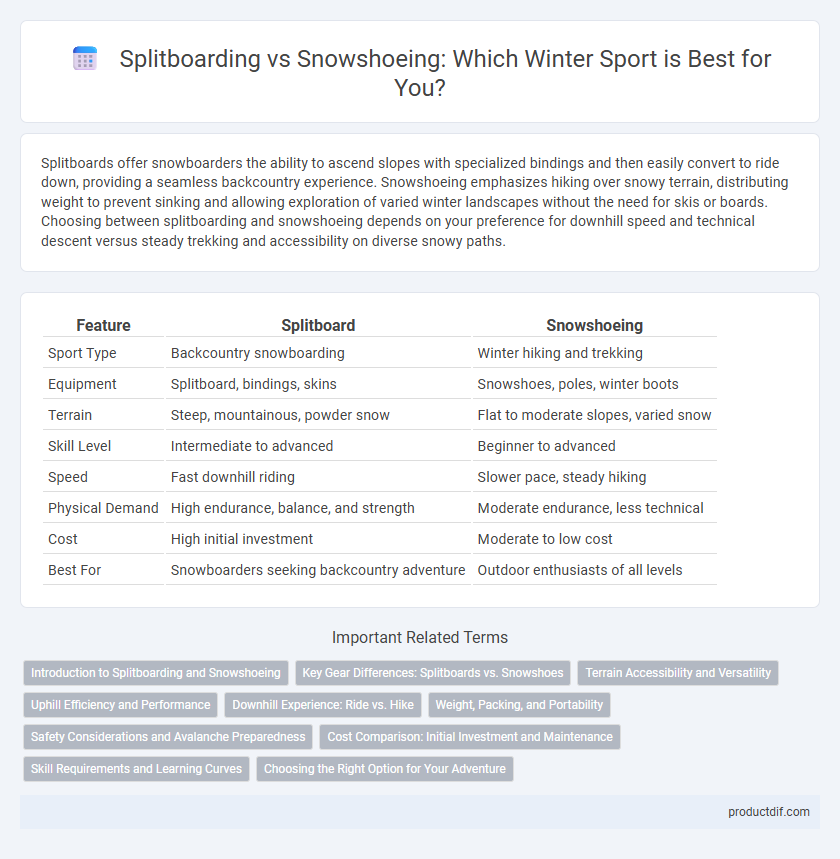Splitboards offer snowboarders the ability to ascend slopes with specialized bindings and then easily convert to ride down, providing a seamless backcountry experience. Snowshoeing emphasizes hiking over snowy terrain, distributing weight to prevent sinking and allowing exploration of varied winter landscapes without the need for skis or boards. Choosing between splitboarding and snowshoeing depends on your preference for downhill speed and technical descent versus steady trekking and accessibility on diverse snowy paths.
Table of Comparison
| Feature | Splitboard | Snowshoeing |
|---|---|---|
| Sport Type | Backcountry snowboarding | Winter hiking and trekking |
| Equipment | Splitboard, bindings, skins | Snowshoes, poles, winter boots |
| Terrain | Steep, mountainous, powder snow | Flat to moderate slopes, varied snow |
| Skill Level | Intermediate to advanced | Beginner to advanced |
| Speed | Fast downhill riding | Slower pace, steady hiking |
| Physical Demand | High endurance, balance, and strength | Moderate endurance, less technical |
| Cost | High initial investment | Moderate to low cost |
| Best For | Snowboarders seeking backcountry adventure | Outdoor enthusiasts of all levels |
Introduction to Splitboarding and Snowshoeing
Splitboarding offers backcountry snowboarders a versatile approach by combining the uphill mobility of skis with the downhill thrill of snowboarding, featuring boards that split into skis for easier ascents. Snowshoeing provides an accessible winter activity using lightweight frames and durable bindings designed to distribute weight over snow, enabling hikers to traverse deep snow without sinking. Both sports emphasize efficient snow travel but cater to different preferences in terrain and equipment, with splitboarding favoring snowboarders seeking backcountry exploration and snowshoeing appealing to those prioritizing ease and stability in snowy landscapes.
Key Gear Differences: Splitboards vs. Snowshoes
Splitboards feature a snowboard that splits into two skis for uphill travel and reassembles for downhill riding, while snowshoes are strapped onto boots to distribute weight and prevent sinking in deep snow. Splitboards require bindings compatible with both climbing and riding modes, often including specialized skins for traction; snowshoes rely on crampons or cleats for grip. The complexity and weight of splitboard gear generally exceed snowshoe setups, reflecting their dual-purpose design for backcountry snowboarding versus primarily walking on snow.
Terrain Accessibility and Versatility
Splitboards offer superior performance on steep, mountainous terrain with deep powder, providing versatility for backcountry snowboarders seeking both uphill and downhill capability. Snowshoes excel in flat to moderate, forested, or marshy areas, allowing users to traverse soft snow and uneven ground where boards may be cumbersome. Terrain accessibility differs as splitboards favor slope-oriented routes while snowshoes enable broader exploration across varied flat and rolling landscapes.
Uphill Efficiency and Performance
Splitboards offer superior uphill efficiency by allowing snowboarders to glide smoothly on snow with specialized climbing skins, reducing energy expenditure on steep terrains. Snowshoes, while effective for walking on deep snow, generate more drag and require more effort to ascend slopes, impacting overall performance. For athletes prioritizing speed and energy conservation during uphill climbs, splitboards provide a notable advantage over snowshoeing.
Downhill Experience: Ride vs. Hike
Splitboarding offers an exhilarating downhill ride with smooth, controlled descents on snow-covered slopes, allowing for dynamic turns and speed similar to traditional snowboarding. Snowshoeing, in contrast, emphasizes a steady hiking experience through snowy terrain, where downhill sections require cautious foot placement and balance rather than speed. The splitboard maximizes downhill enjoyment, while snowshoeing focuses on exploration and endurance in winter landscapes.
Weight, Packing, and Portability
Splitboards offer a lightweight and compact design that enhances uphill efficiency and ease of packing compared to traditional snowboards. Snowshoes tend to be bulkier and heavier, making them less portable and more cumbersome to carry on backcountry trips. The ability to disassemble splitboards into manageable parts significantly improves portability and storage convenience for winter outdoor activities.
Safety Considerations and Avalanche Preparedness
Splitboards offer enhanced stability and control on steep terrain, reducing the risk of slips that can trigger avalanches, while snowshoes enable easier movement in deep, unstable snow but may provide less traction on icy slopes. Avalanche preparedness with splitboarding requires carrying essential safety gear such as transceivers, probes, and shovels, along with knowledge of terrain features and snowpack conditions to minimize danger. Snowshoers should also equip themselves similarly, but their typically slower pace and lower terrain usage can affect rescue response times and risk management strategies.
Cost Comparison: Initial Investment and Maintenance
Splitboards typically require a higher initial investment, ranging from $700 to $1,200 for the board and bindings, while snowshoes cost between $150 and $400 depending on materials and brand. Maintenance for splitboards involves regular tuning, waxing, and occasional repairs, which can add to the overall expenses, whereas snowshoes need minimal upkeep, mainly cleaning and strap adjustments. Choosing between the two often depends on budget constraints and the intended use, with splitboards generally demanding more upfront and ongoing costs.
Skill Requirements and Learning Curves
Splitboarding demands intermediate to advanced snowboarding skills, with a steeper learning curve due to the need to master transitioning between uphill and downhill modes. Snowshoeing requires minimal technical skills, making it accessible for beginners and those seeking straightforward navigation across snowy terrain. Skill acquisition in splitboarding involves balance and edge control, while snowshoeing primarily focuses on endurance and basic hiking techniques.
Choosing the Right Option for Your Adventure
Splitboards provide a versatile option for backcountry snowboarding, offering efficient uphill travel and seamless descent on varied terrain, ideal for riders seeking both performance and convenience. Snowshoeing excels in stability and accessibility, making it perfect for exploring deep snow and uneven trails, especially for those prioritizing ease and endurance over speed. Consider your adventure goals, fitness level, and terrain preferences when choosing between the dynamic mobility of splitboards and the reliable support of snowshoes.
Splitboard vs snowshoeing Infographic

 productdif.com
productdif.com